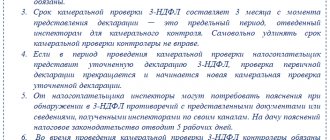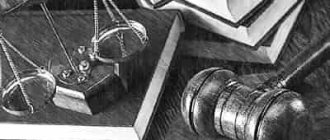Home / Taxes / What is VAT and when does it increase to 20 percent? / Declaration
Back
Published: September 18, 2017
Reading time: 8 min
0
58
The correctness of VAT calculation, its amount and timely payment to the state budget are regulated by the tax authorities. Thanks to the transition to electronic reporting, monitoring the accuracy of data provided by organizations has become much easier. If inconsistencies are identified, a desk audit is carried out.
- Desk inspection: definition and subject
- How is it produced?
- What is the time frame for production?
- Deadline for making a decision on a desk audit
- If an updated declaration is submitted during the inspection
- In what cases will additional documents be required?
- At what stage is the inspection of the territory carried out?
- Tax monitoring and desk audit
Dear readers! To solve your problem, call hotline 8 or ask a question on the website. It's free.
Ask a Question
How is the verification carried out?
Inspectors control:
- whether the fee payable has been calculated correctly;
- whether the tax base is underestimated;
- whether there is an overestimation of deductions;
- legitimacy of the use of deductions.
The taxpayer has the right to refund VAT from the budget upon completion of audit activities.
The audit is carried out on the territory of the Federal Tax Service without calling a legal entity. faces. The timing of a desk audit for VAT is regulated by Law No. 302-FZ. Inspectors check the submitted report. Tax officials notify the company if discrepancies are identified.
There are three stages of action:
- Submitting reports to the Federal Tax Service.
- Desk check. Federal Tax Service employees check the ratio of indicators within the report. They are compared with the values of reporting submitted for previous periods to identify deviations.
- Recording the results of the audit.
We list the points that Federal Tax Service employees pay attention to during the audit. The VAT report contains figures for invoices “incoming” from partners and issued to customers by the company.
Inspectors compare the deductions submitted by the organization with the supplier’s VAT. Tax officials consider the time period for which the report was sent.
At the Federal Tax Service, the report is loaded into the software. It is used to compare the numbers reflected in the invoices of customers and contractors to detect:
- Differences in VAT figures between the contractor and the customer for completed transactions.
- Deductions not reflected from counterparties.
With the help of the inspection program, they are fighting against “gray” organizations.
When discrepancies are detected, the Federal Tax Service's program itself, without the participation of an inspectorate employee, generates a request for clarification of the data.
Attached is a list of documentation where inaccuracies were identified, with the code designation:
- “I” – the partner’s report does not contain information about the declared transaction;
- “II” – discrepancy in information in the books of sales and purchases;
- “III” – discrepancies were identified in information about incoming and outgoing invoices;
- “IV” – when erroneous data is identified.
Now about the extension of the desk audit on VAT. If inspectors during an inspection catch a company in violation, the inspection period is increased to 3 months. Conclusions about increasing the deadlines are accepted by the inspection management.
Deadlines for checking a tax return
The period for verifying a VAT return can be from 2 to 3 months. This depends on the degree of “good faith” and “transparency of the environment” in which the taxpayer operates. Depending on this, the category of tax risk is individually determined, allowing (or not allowing) a reduction in the period of desk audit to 2 months.
The criteria for classifying a payer as one for whom the cameral period, including for VAT reimbursement from the budget, is 2 months, are established by the Federal Tax Service itself. The actual assignment of the person who filed the declaration to one or another tax risk category occurs using the ASK VAT-2 system (letter of the Federal Tax Service of Russia dated July 13, 2017 No. ММВ-20-15 / [email protected] ).
From 09/03/2018 in accordance with clause 2 of Art. 88 of the Tax Code of the Russian Federation, as amended by Law No. 302-FZ of August 3, 2018, reduced the period for desk audit of a VAT declaration from 3 to 2 months. It is also worth noting here that if any cases of violation of tax laws are detected, the period can be extended to 3 months. The basis for increasing the audit period may be a decision of the immediate head of the tax authority or his deputy.
How to prepare for a VAT audit
When auditing VAT, controllers study the documentation. If errors are discovered, the tax amount will not be refunded.
In an invoice providing a tax deduction, it is not permissible to allow inaccuracies:
- incorrectly reflect the VAT rate;
- make a mistake in the name of the partner.
There are minor inaccuracies in the invoice for which a deduction is provided.
Inspectors meticulously check the documentation. The deadline for conducting a desk audit of a VAT return is not extended. Photocopies are certified using templates. Documentation is provided within ten working days from the date of receipt of the request.
Timely tax payments and the absence of gray payment evasion schemes guarantee passing the audit without any comments.
- Involvement of specialists in optimizing tax payments based on legislation.
- Before sending the report, reconcile invoices with partners.
- Prudent selection of contractors who do not violate laws.
If tax officials find contradictions, it is important to peacefully resolve their requests. A company has the right to challenge a refusal to refund VAT in court.
What happens after the audit is completed
After sending certified photocopies of documentation with an inventory to the Federal Tax Service, they await the results of audit activities. If Federal Tax Service employees do not find any errors in the documents, then seven days after the completion of the audit they make a decision on the return of tax amounts.
How to defend money from the Federal Tax Service? If shortcomings are found in the act, this is not a reason to give up. The company has a chance to defend tax deductions. It is required to submit an appeal, confirming their validity. The company has one month to object to the inspection report.
In case of underpayment of VAT and other fees, including penalties and fines, tax authorities have the right to offset the amount of tax to be reimbursed against the payment of debts. In order not to encounter such a situation, a reconciliation with the Federal Tax Service is carried out in advance.
Powers of representatives of Federal Tax Service employees during audit actions
The decision of the head of the Federal Tax Service is not required to begin the inspection. Notification of the start of verification actions is not sent to a legal entity.
The inspection is carried out after submitting an initial or updated declaration to the inspectorate. Inspectorate employees have the right:
- require documentation;
- request clarifications or clarifications in the reporting;
- carry out document seizure;
- request data from counterparties;
- question witnesses;
- organize an examination;
- go inspect the premises.
The audit is carried out by authorized officials of the Federal Tax Service.
Desk audit of VAT for refund in 2020
The first question after receiving a request: how to collect documents within the deadlines established by the Tax Code and avoid liability for failure to comply with its norms?
Important! For each tax claim document not submitted or submitted late, a fine of 200 rubles is possible. (clause 1 of article 126 of the Tax Code of the Russian Federation).
There is no need to immediately drop everything and collect the entire requested list. It is important to make sure that all the documents listed in the request relate to the declaration being verified and confirm the information reflected in its lines.
Important! During a desk audit, tax officials can request only those documents that directly relate to the subject of the audit (Article 88 of the Tax Code of the Russian Federation).
If the requested information does not relate to the declaration being verified, controllers do not have the right to demand it (clause 7 of Article 88 of the Tax Code of the Russian Federation).
It will be difficult for tax authorities to punish a company for failure to submit such documents - judicial practice is mainly on the side of the taxpayer. For example, the FAS Resolution No. A45-2243 dated October 09, 2013 states that the primary documents confirming the right to deduct VAT do not include balance sheets, account analyzes and other accounting registers.
However, sometimes you can find a different judicial position when judges support the right of the tax authority to independently determine the list of requested documents (Resolution of the Federal Antimonopoly Service of the Moscow District dated October 4, 2006 No. KA-A40/9438-06). The ambiguity of the situation is explained by the fact that the criteria for selecting documents for verification are not defined in the Tax Code of the Russian Federation.
Having found out that some of the documents were requested incorrectly, it is risky to simply reduce their volume - it is better to send a letter to the tax authorities explaining the reason for the non-submission of certain documents. In the text of the letter, you can make a reference to clause 2.8 of the Federal Tax Service letter dated July 16, 2013 No. AS-4-2/12705, in which the tax authorities themselves indicated that the inspector’s right to request documents during desk audits is limited.
When a desk audit of VAT is carried out, inspectors especially carefully study primary documents and invoices. If deficiencies are identified in them, you can not count on VAT refund.
An invoice is one of the main documents giving the right to deduct VAT. It is unacceptable to indicate an incorrect tax rate or make an error in the name of the seller (buyer), which prevents it from being correctly identified (letter of the Ministry of Finance dated 05/07/2015 No. 03-01-11/26312).
Although an error in the invoice details does not always lead to the impossibility of deduction. For example, the deduction is not prevented by incomplete information about the customs declaration number in column 11 (letter of the Ministry of Finance dated February 18, 2011 No. 03-07-09/06) or the absence of a code for the unit of measurement of goods in column 2 (letter of the Federal Tax Service dated July 18, 2012 No. ED- 4-3/).
For more information about errors in invoices that do not prevent deduction, read the article “What errors in filling out an invoice are not critical for VAT deduction?”
Even if the invoice is perfect, you can still lose the deduction if errors are found in the original invoice.
Important! Mandatory details of the primary document are given in Art. 9 of Law No. 402-FZ.
Read more about the requirements for the primary document in the material “Primary document: requirements for the form and the consequences of its violation.”
In the process of communication between a company and tax authorities as part of an audit, every detail is important. For example, copies of documents provided must be prepared in a special way - otherwise they will simply not be accepted for verification. Let's look at this in more detail.
Let's continue the example: Hellas LLC collected the necessary documents within the prescribed period according to the request sent by the inspectors.
Important! The documents requested as part of the desk audit must be submitted within 10 working days from the date of delivery of the request (Clause 3 of Article 93 of the Tax Code of the Russian Federation).
Company employees prepared copies of the requested documents and certified them properly.
Important! From April 2020, companies may no longer use the round seal in documents drawn up on paper (Law No. 82-FZ dated 04/06/2015).
To find out whether it is possible to submit documents to the tax office without a stamp, read the article “Tax officers were required to accept documents without a stamp.”
Hellas LLC stamped the copies. The company proceeded from the following: the term “certified copies” is not defined in the Tax Code, and therefore whether it is now necessary to put the company’s seal on the copy is not completely clear. On this issue, Ministry of Finance officials refer to GOST R 6.30-2003 (clause 3.26), according to which copies of the document should be stamped. To avoid unnecessary nagging from inspectors, the company decided to play it safe and put the seal on anyway.
The basis for this may be:
- Inconsistency of data contained in the documents of the organization’s counterparties;
- A refund declaration has been submitted;
- An updated declaration was submitted for the period two years ago.
To do this, a written requirement is drawn up, which contains:
- Article of the Tax Code on the basis of which the requirement was drawn up;
- Deadline for submitting documents;
- List of documents indicating details, tax period;
- Details of the organization being inspected;
- Tax control event to which this requirement applies (For example, Desk audit for the second quarter of 2017).
The demand is delivered personally to a representative of the organization or sent by registered mail, if it is not possible to submit it in the first way. In this case, after six days it is considered accepted, regardless of whether the addressee received it or not (clause 1 of Article 93 of the Tax Code of the Russian Federation).
The list of documents provided includes:
- Invoices;
- Books of purchases and sales;
- Primary documents.
Situations also arise when the inspection lists many additional clarifying documents - analysis of accounts, related to accounting policies, and others.
The list can be quite significant, and 10 days are allocated for the provision of documents. For failure to provide one or more, a fine of two hundred rubles per unit is imposed. You can write a letter requesting an extension of the specified period on the day the request is received. The tax office must provide a response within two days.
All required documentation must relate to the period under review; otherwise, excessively requested documents may not be provided - liability for this is not provided for by law. In order to protect yourself from litigation and loss in it, it is better to immediately send an explanation to the inspectorate, based on clause 2.8 of the Federal Tax Service letter dated July 16, 2013 No. AS-4-2/12705 on restrictions on the requested documentation.
When paying VAT, much fewer documents are required than when filing a return for reimbursement.
Errors in filling out invoices, which are not grounds for refusal to accept deductions, include errors and inaccuracies that do not prevent identification:
- seller and buyer of goods, works, services, property rights
- name of goods, works, services, property rights
- invoiced value
- tax rate and amount of tax presented to the buyer of goods, works, services, property rights. Reason - Letter of the Ministry of Finance of the Russian Federation dated 05/07/2015 No. 03-01-11/26312
Actions of the company upon receipt of a request from the Federal Tax Service
Confirmation of admission is sent to the Federal Tax Service within 6 days. If confirmation is not sent, the Federal Tax Service restricts movements on the company’s current account.
Next, they control the report, check with customers and send a response in tabular form, or an updated report. Or a message to the Federal Tax Service employees that there are no shortcomings in the company. The response is sent via electronic reporting systems within 5 days from the date of receipt of the request.
For failure to provide explanations, the company is fined five thousand rubles, for a secondary case - twenty thousand rubles.
Tax monitoring as an alternative to desk audit
The beginning of 2020 was marked by a new form of control - tax monitoring. It represents an alternative to desk and on-site inspections. Its meaning is that the taxpayer provides tax authorities with access to all documents and accounting procedures, and the tax authority checks the correctness of calculation and timely payment of taxes, including VAT. Tax monitoring is carried out exclusively on a voluntary basis. The taxpayer must submit an application to the tax authority no later than July 1 of the year preceding the year of tax monitoring. Example: If you want to switch to tax monitoring in 2020, then the last day to submit the corresponding application to the tax authority is July 1, 2016. In addition, there are a number of conditions that a taxpayer must meet in order to switch to a new form of control. These conditions relate to the taxpayer's assets, his income and taxes that must be paid to the budget. Please note: although monitoring replaces other forms of control, if fiscal officials identify violations in the period for which it was carried out, they have the right to open a desk or on-site inspection. This is also possible when filing a return for reimbursement and submitting an amendment with a reduced amount of VAT payable.
What documents are provided upon request?
Federal Tax Service employees require documentation if:
- The company submits the tax for a refund. The state does not transfer money without reason. Reimbursement reports are checked scrupulously.
- If the company enjoys tax benefits.
- Inconsistencies with partner information led to a reduction in tax or an increase in refund amounts.
- When revising a “clarification” submitted later than 2 years after the deadline fixed for submitting the initial report.
A package of documentation at the request of the Federal Tax Service is prepared and sent within ten days from the date of receipt of the request. The Federal Tax Service does not have the right to request original documentation. The list of documents required by the Federal Tax Service is open.
The right of tax officials to inspect premises
The right to inspect offices is granted to employees of the Federal Tax Service if tax understatement is detected. Inspectors have the right to inspect partners' offices. For inspection, employees are required to present a document signed by the head of the Federal Tax Service.
If there are no errors in the report, the Federal Tax Service does not send demands to the company. If the Federal Tax Service did not disturb the company, the desk audit was carried out without complaints.
If deviations are detected, Federal Tax Service employees send a desk audit report to the company within ten days after completion. The organization has 10 days to submit objections. If no violations are identified, the tax office does not require explanations and does not request a primary report.
Reports that have been checked are not controlled again. Inspectors are auditing.
Inspection of the territory during a desk audit of VAT
The main change in the procedure for conducting a desk audit of VAT was the possibility for tax authorities to inspect the premises and property of the taxpayers being inspected (Article 92 of the Tax Code of the Russian Federation). In addition, the department allows such an inspection of counterparties, but for this there must be a compelling reason to believe that the amount of tax calculated for payment is underestimated. Although the courts take a different point of view. Thus, the Federal Antimonopoly Service of the Volga District, in its resolution dated December 8, 2011 No. A55-3314/2011, indicated that an inspection can only be carried out at the subject being inspected.
But the Federal Tax Service takes the position that an inspection is possible and points out the reasons for its conduct:
- the presence of information allowing one to conclude that the amount of VAT payable is underestimated or the amount to be reimbursed is overstated;
- filing a VAT return for refund.
If these grounds exist, the tax inspector issues a decision to conduct an inspection. It is necessary to note that such a resolution must necessarily contain a motivating reason for the inspection and the signature of the management of the tax authority. If the document is drawn up correctly, then it is impossible to refuse access to the territory. In this case, all that remains is to check whether the tax inspector has an official identification card. Thus, this innovation expanded the scope of authority when conducting a desk audit of VAT and made it possible to carry out control activities outside the inspectors’ workplaces.
Extended audit actions
During extended audit actions, in addition to checking indicators, inspectors have the right to:
- request photocopies of documentation from the company;
- make a reconciliation with partners and appoint an examination.
Increased interest from the Federal Tax Service does not indicate that the company has serious violations. Let us outline how a desk audit for VAT takes place. The deadlines for 2020 reimbursement are the same as for a regular camera.
An extended “camera room” is prescribed:
- if the company applies payment benefits;
- The report records the VAT refund. Organizations try not to reflect return figures in declarations. From 2020, VAT deductions can be carried forward for three years;
- the VAT return contains information about transactions that contradicts the information in the return submitted by another company. that is, the company and its partner in the same transaction have different tax figures.
- after two years, with an increase in the amount of loss or a decrease in tax;
- a report on taxation for the use of subsoil has been submitted.
If none of the above points are present, the organization has the right to refuse the Federal Tax Service and not send the documentation.
KNI VAT return – what is it?
VAT returns are submitted to the Federal Tax Service only in electronic format. Data on desk audits of these reports are also filed electronically. All information is systematized in the PIK (software and information complex) “VAT” database. “VAT_KNP” is a module of this program, which consists of information collected at three levels of information resources - local, regional and federal. Information is taken from VAT returns, the desk tax audit service, accounting logs for credits, returns, and pre-trial settlements of disputes. The operating regulations of this program are presented in the Letter of the Federal Tax Service dated 05.05.2014 No. ED-4-15/8603.
How to appeal the results of a desk audit
There are two ways to refute the tax decision. File an appeal with a higher-ranking inspectorate, and if you are not satisfied with its conclusion, go to arbitration.
An official of a higher rank, having received a complaint, has the right:
- do not take action. Leave the conclusion in force, but not satisfy the petition;
- abolish or change the conclusion of the Federal Tax Service in whole or in half;
- accept your opinion on the taxpayer’s issue;
- cancel the verdict of the Federal Tax Service completely.
The period for consideration of the complaint is 1.5 months. The Federal Tax Service employees report the results in writing.
They apply to the Arbitration Court after appealing the inspectors’ act to a higher-ranking body. There is a three-month period for filing a claim. It is calculated from the day the decision on the complaint is received, or from the end of the month provided for the response from the highest-ranking body.
Changing the timing of desk audits
Since 2020, the Federal Tax Service has introduced a risk-based approach to desk audits of VAT returns.
If the taxpayer who submitted the VAT Return, in which VAT is claimed for reimbursement, belongs to taxpayers assigned a low or medium tax risk, for such a taxpayer the period of the desk audit may be reduced to 2 months. Conditions that must be met to reduce the inspection period:
- the amount of tax presented for reimbursement must not exceed the total amount of taxes (VAT, income tax, excise taxes) paid for the three previous calendar years. The amount is verified as of the date of submission of the VAT Return.
- 90% of the deductions claimed on the VAT return must be attributed to low tax risk sellers. These data are assessed no later than 10 calendar days after the deadline for submitting the VAT Return.
Answers to common questions
Question No. 1. During a desk audit of VAT for reimbursement, the Federal Tax Service requires the submission of balance sheets for accounting accounts and an extract from the accounting policy. Are the actions of the Federal Tax Service legal?
In our opinion, the actions of the Federal Tax Service are unlawful. There is judicial practice in favor of taxpayers. For example, in the Resolution of the Federal Antimonopoly Service No. A45-2243 dated October 09, 2013, the judicial authority noted that accounting registers (turnover balance sheets, account analyzes, etc.) do not belong to the primary documents confirming the right to deduct VAT.
Question No. 2. We have errors in maintaining the chronology of invoice numbering. Can such errors have a negative impact on obtaining a VAT deduction?
This error is not critical. VAT can be deducted.
Question No. 3. We had a need to submit an updated VAT return for the 1st quarter of last year. According to the updated declaration, VAT was refundable. The amount is small, what is the procedure for conducting a desk audit in this case?
A desk audit of such a declaration will be carried out according to the same rules that would apply to the original declaration, which reflects the VAT refund.
What is a desk audit and why is it needed?
A desk audit is necessary to identify any kind of errors and discrepancies in the reporting submitted by organizations. As a rule, it is carried out on the territory of the tax authority, and all necessary papers and explanations, if required, can be requested from the company remotely through communication channels.
The immediate subject of the audit is the VAT tax return, where companies indicate all the information necessary for the calculation and payment of tax. The audit begins without a special decision from the tax authorities for each submitted declaration. Companies do not receive any notification about the start of verification activities. You should expect feedback from the Federal Tax Service only if shortcomings are identified.
The verification begins after the Federal Tax Service Inspectorate receives the declaration. If necessary, the company or individual entrepreneur sends to the tax office (and at its request) copies of all necessary papers. Each document must have the seal and signature of the head of the organization. Copies must be certified and stamped “Correct copy.” After verification, all copies remain with the tax office.
NOTE! Since January 2020, the tax service has received the right not only to check the documentation of enterprises during the cameral, but also to inspect the premises of taxpayers during the audit.
Thus, a desk audit is a check of the reliability and correctness of the information that companies reflect in their reporting. It is carried out to ensure that VAT has been calculated, charged and refunded correctly.
Conducting a desk audit: what is required for this
According to the order of the Federal Tax Service of the Russian Federation “On approval of the VAT tax return form...” dated October 29, 2014 No. ММВ-7-3 / [email protected] , a standard declaration form was developed, as well as rules that must be followed when filling out and submitting it. It is this form, submitted by the taxpayer to the Federal Tax Service, that is the start for the audit.
As for documents, here the enterprise may be required to provide any papers that directly or indirectly relate to the operations and data specified in the submitted declaration. A request from the tax office may be received in the following cases:
- data differs for different taxpayers for the same transaction;
- the information in the declaration does not match the information in the invoices;
- two years after the due date, the amendment is submitted, and the tax amount in it is less;
- the declaration is submitted by a foreign company that provides services in electronic form to individuals;
- other inconsistencies were identified.
The reasons for requesting the relevant documents must be compelling. This may be the conclusion of the tax authorities that the company wanted to pay less tax than it should by law. Or it has been established that they are deliberately trying to inflate the amount of compensation from the state budget. The tax office may not request documents if they have already been received during earlier inspections.
All that is required from a company to conduct a desk audit for VAT is to submit a tax return on time, as well as submit to the Federal Tax Service, if necessary, all documents that can confirm the data included in the declaration.
What to do if the tax office sent a desk audit report
If there are no complaints from the tax company, no further action is required. In this case, you should also not wait for documents based on the results of the inspection. But if the tax authorities have any questions, then after the audit is completed, a desk tax audit report will be drawn up (an addition to the report can also be drawn up). The documents will be transferred to the organization within a few working days. If the company does not agree with the facts in this act, then it can send its objections to the Federal Tax Service. The tax office must consider all objections received within 10 working days. If the company agrees with the objections, then you just need to submit an updated declaration.
ATTENTION! The duration of the VAT refund depends on the duration of the audit. Now, with the law on reducing the inspection period coming into force, it will be faster to offset the tax or return it (under Article 176 of the Tax Code of the Russian Federation). VAT reimbursement arises when, at the end of the quarter, tax deductions turned out to be greater than accruals (clause 2 of Article 173 of the Tax Code). To recover VAT in this case, an application for credit or refund must be attached to the declaration.
Thus, it is difficult to determine the specific time period that the audit will take. Everything will depend on whether the inspectors have any questions or not, whether any documents are required to clarify the information and other information. The minimum period for verification is 2 months.










